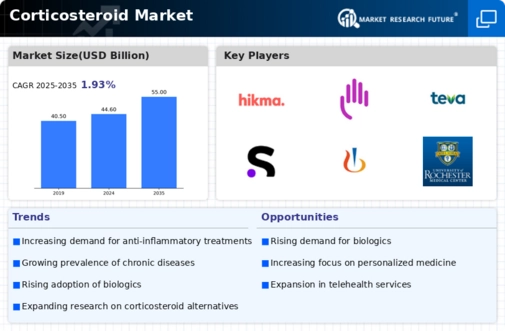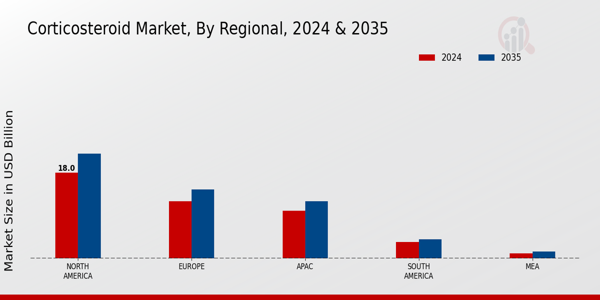Advancements in Drug Formulations
Innovations in drug formulations significantly influence the Global Corticosteroid Market Industry. The development of new delivery systems, such as inhalers and injectables, enhances the efficacy and safety profiles of corticosteroids. For example, the introduction of combination inhalers has improved asthma management, leading to better patient adherence. These advancements not only expand the therapeutic applications of corticosteroids but also cater to diverse patient needs. As a result, the market is projected to reach 55 USD Billion by 2035, reflecting the positive impact of these innovations on treatment outcomes and patient satisfaction.
Increasing Awareness and Education
The Global Corticosteroid Market Industry benefits from heightened awareness and education regarding the therapeutic uses of corticosteroids. Healthcare professionals and patients are increasingly informed about the benefits and risks associated with corticosteroid therapies. Campaigns aimed at educating the public about chronic diseases and their management have led to a rise in corticosteroid prescriptions. This trend is likely to contribute to a compound annual growth rate (CAGR) of 1.93% from 2025 to 2035, as more individuals seek effective treatment options for their conditions, thereby expanding the market further.
Market Trends and Growth Projections
Emerging Markets and Global Expansion
The Global Corticosteroid Market Industry is witnessing growth in emerging markets, where increasing healthcare access and economic development are driving demand for corticosteroid therapies. Countries in Asia-Pacific and Latin America are experiencing a rise in chronic disease prevalence, necessitating effective treatment options. As healthcare infrastructure improves, more patients gain access to corticosteroid medications. This trend is likely to contribute to the overall market growth, with projections indicating a market size of 55 USD Billion by 2035, as these regions become increasingly integral to the global corticosteroid landscape.
Rising Prevalence of Chronic Diseases
The Global Corticosteroid Market Industry experiences a notable surge in demand due to the increasing prevalence of chronic diseases such as asthma, rheumatoid arthritis, and inflammatory bowel disease. These conditions often require long-term management, leading to a higher consumption of corticosteroids. For instance, asthma affects approximately 300 million people globally, necessitating effective treatment options. This growing patient population is expected to drive the market, contributing to its valuation of 44.6 USD Billion in 2024. As healthcare systems adapt to these rising demands, the Global Corticosteroid Market Industry is poised for sustained growth.
Regulatory Support for Corticosteroid Use
Regulatory bodies play a crucial role in shaping the Global Corticosteroid Market Industry by providing guidelines and approvals for corticosteroid medications. The endorsement of corticosteroids for various indications by agencies such as the FDA and EMA fosters confidence among healthcare providers and patients. This regulatory support not only facilitates the introduction of new corticosteroid products but also ensures their safety and efficacy. Consequently, the market is expected to thrive, with a projected valuation of 44.6 USD Billion in 2024, as regulatory frameworks continue to evolve in favor of corticosteroid therapies.























